Abstract
Taking high nitrogen aluminum dross as the research object, the effects of the additives sodium carbonate and cryolite and the roasting process on the denitrification effect of aluminum dross were studied. The principle of additive denitrification was studied by XRD, SEM and TG-DSC. The experimental results show that sodium carbonate and cryolite can quickly reduce the content of aluminum nitride in aluminum dross. The optimum denitrification process parameters were also obtained simultaneously. When the mass ratio of cryolite to aluminum dross was 0.4, the roasting temperature was 900 °C, and the roasting time was 3 h, the denitrification degree could reach 96.19%. When the mass ratio of sodium carbonate to aluminum dross was 0.8, the roasting temperature was 1000 °C, and the roasting time was 4 h, the denitrification degree could reach 91.32%. This study provides a reference for the non-harmful treatment of high nitrogen aluminum dross.
1. Introduction
Aluminum dross is a kind of waste produced in the process of electrolytic aluminum furnace front casting and aluminum alloy casting. According to the National Hazardous Waste List (2021 Edition) [1], aluminum dross is recognized as hazardous waste. According to the content of nitride and fluoride, aluminum dross is divided into high-nitrogen aluminum dross and high-fluoride aluminum dross. Between these, high-nitrogen aluminum dross is mainly produced in the secondary aluminum process, and high fluoride aluminum dross is mainly produced in the aluminum electrolysis process [2,3,4]. At present, the treatment method for aluminum dross is still mainly stacking and landfill, but when aluminum dross that has not undergone non-harmful treatment is landfilled or stacked, inorganic salts dominated by NaCl and KCl will enter the soil, resulting in the aggravation of land salinization, and fluoride ions will penetrate into the soil and groundwater. When exceeding the discharge standard in the national standard, it is easy to cause high-fluoride water and high-fluoride soil and to induce immune diseases [5,6,7,8]. Therefore, a low-cost and high-efficiency non-harmful aluminum dross treatment method is a top priority. Many scholars have studied the non-harmful treatment of aluminum dross. Based on the response surface method, Wang [9] carried out research on the influence of cryolite (Na3AlF6), roasting temperature and soaking time on the denitrification degree of secondary aluminum dross. Li [10] achieved nitrogen removal and fluoride retention with the addition of calcium salt (CaCl2) and the roasting of aluminum dross at a high temperature (1300 °C). With sodium carbonate (Na2CO3) and cryolite as additives, this study attempted to explore the effect of the additive ratio, roasting temperature and roasting time on the nitrogen removal effects of high-nitrogen aluminum dross, as well as the phase transformation law of high-nitrogen aluminum dross under different roasting conditions.
The aluminum dross obtained after non-harmful treatment can be used in many fields. Taking the treatment results of this paper as an example, the experimental samples treated with cryolite could be returned to the electrolytic cell for reuse and NaAlO2 could be obtained from the samples treated with sodium carbonate by solid–liquid separation and other purification methods.
2. Materials and Methods
2.1. Raw Material, Reagent and Instrument
Raw material: high-nitrogen aluminum dross obtained by recovering part of the aluminum from the primary aluminum dross (Jiangsu Haiguang Metal Co., Ltd., Suqian, China).
Reagents: sodium carbonate (analytical purity, Jiangsu Qiangsheng Functional Chemical Co., Ltd., Suzhou, China), cryolite (analytical purity, Shanghai Maclean Biochemical Technology Co., Ltd., Shanghai, China), sodium hydroxide (analytical purity, Xilong Chemical Co., Ltd., Shanghai, China), hydrochloric acid (analytical purity), Shanghai Lingfeng Chemical Reagent Co., Ltd., Shanghai, China), methyl red (indicator, Shanghai Yuanye Biotechnology Co., Ltd., Shanghai, China), methylene blue (indicator, COOLABER SCIENCE&TECHNOLOGY, Beijing, China), and boric acid (chemical purity, Shanghai Myreel Chemical Technology Co., Ltd., Shanghai, China).
Instruments: programmable box furnace (SXL-1230, Hangzhou Zhuo Chi Instrument Co., Ltd., Hangzhou, China), universal electric furnace (DK-98-II, Xinghua Chushui Electric Heating Appliance Factory, Jiangsu Province, Xinghua, China), ultra-pure water system (EPED-10TH, Nanjing Yipu Technology Development Co., Ltd., Nanjing, China), X-ray fluorescence spectrometer (ZSX PRIMUS III+, Japan Science Co., Ltd., Osaka, Japan), X-ray diffractometer (D8 Advance, Bruker (Beijing) Technology Co., Ltd., Beijing, China), field emission scanning electron microscope system (ZEISS sigma HD, Carl Zeiss (Shanghai) Management Co., Ltd., Shanghai, China), and synchronous thermal analyzer (STA 449 F3, NETZSCH Instrument Manufacturing Co., Ltd., Selb, Germany).
Technical parameters of the relevant test instruments:
- (1)
- XRD: the maximum output power was 3 KW, the voltage was 20–60 kV, the current was 2–60 mA, and the radius of the goniometer was 185 mm. MDI jade 9 was used for the XRD analysis. The XRD database was in PDF 2009 format.
- (2)
- SEM-EDS: the acceleration voltage was 10 kV, the magnification was 100–200 k, and the secondary electron resolution was 1 nm.
- (3)
- TG-DSC: the heating rate was 10 °C/min, the weighing resolution was 0.1 μg, and the vacuum degree was 10−4 mbar.
2.2. Experimental Method
First, a total of 50 g aluminum dross and additives were placed in the corundum crucible according to the additive ratio. The mixture was mixed in the corundum crucible evenly with a stirring rod. Then, the corundum crucible was placed in a programmable box furnace and fired at a certain temperature (50–1000 °C). Subsequently, the corundum crucible was taken out and cooled at room temperature. Finally, the content of aluminum nitride in the aluminum dross was measured, and the denitrification degree was calculated.
The denitrification degree test method adopted the distillation separation neutralization titration method [11,12]. The treated aluminum dross was ground, 2 g weighed, and 150 mL NaOH solution poured with a mass fraction of 20 wt.% into the conical flask, and the cork of the conical flask quickly tightened. The conical flask was heated on the asbestos net of the universal electric furnace, the mixed solution heated in the conical flask to boiling point and kept boiling for 2 h, and the ammonia distilled from the conical flask absorbed with 200 mL and 40 g/L boric acid solution. After distillation, the solution was titrated with 0.05 mol/L dilute hydrochloric acid solution, with standard methyl red–methylene blue as the indicator. The end point of titration was the sudden change of the solution from blue to purple red. Alumina was used as the blank control group. The formula for calculating the content of aluminum nitride in aluminum dross was as shown in Formula (1). The calculation formula of the denitrification degree was as in Formula (2) [13].
where W1 is the aluminum nitride content in the sample (%); V1 is the volume of dilute hydrochloric acid consumed by the test sample (mL); V2 is the volume of dilute hydrochloric acid consumed by the blank control group (mL); C is the concentration of dilute hydrochloric acid (mol/L); M is the mass of the test sample taken during measurement (g); b is the total mass of aluminum dross added to the test sample under the current additive ratio (g); Xb is the denitrification degree (%); and W2 is the aluminum nitride content in the original aluminum dross (%).
3. Results and Discussion
3.1. Nature of the Aluminum Dross
As shown in Figure 1, the XRD pattern of the high-nitrogen aluminum dross mainly contained Al2O3, AlN, NaCl, and other substances. Figure 2 shows the TG-DSC analysis result for the high-nitrogen aluminum dross. According to the TG curve in Figure 2, during the roasting process, the mass of the high-nitrogen aluminum dross showed a decreasing trend. The total weight loss of the sample was 6.03%, which was mainly due to the evaporation of adsorbed water on the sample surface or the decomposition of other surface materials and impurities. There was no obvious endothermic peak or exothermic peak in the DSC curve. Figure 3 shows the micromorphology and energy spectrum analysis of the high-nitrogen aluminum dross. The high-nitrogen aluminum dross was mainly composed of a variety of irregular and adherent small particles. According to the corresponding EDS analysis results, it could be seen that in the high-nitrogen aluminum dross, AlN did not exist alone, but was mixed with alumina—part of it was even wrapped by alumina, which made it difficult to remove AlN efficiently.
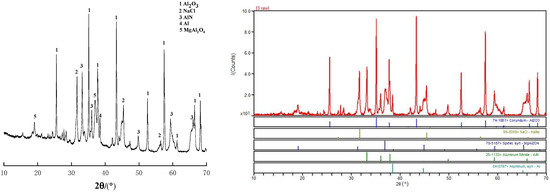
Figure 1.
XRD pattern of the raw material.
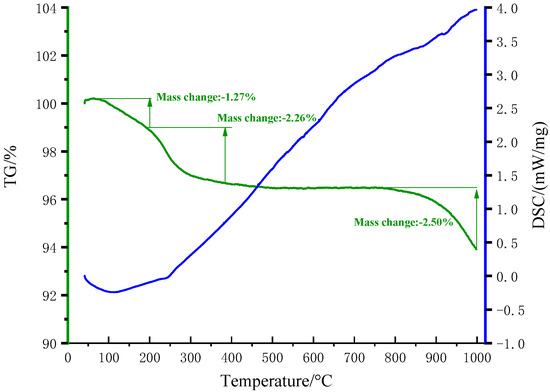
Figure 2.
TG-DSC of the raw material.
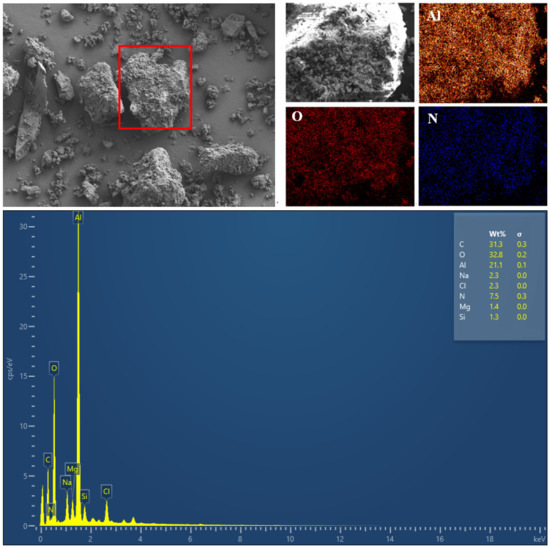
Figure 3.
SEM-EDS of the raw material.
3.2. The Effect of Cryolite and Sodium Carbonate on the Nitrogen Removal of High-Nitrogen Aluminum Dross by Roasting
Cryolite is a commonly used flux for industrial aluminum production that destroys the oxide film wrapped on the surface of the AlN by melting alumina [14]—thereby exposing the AlN to the air more and improving the efficiency of the nitrogen removal. In contrast, the properties of sodium carbonate are relatively stable. However, a small part of sodium carbonate will decompose to produce oxygen during the roasting process. [15] As shown in Formulas (3) and (4), the oxygen content in the sample was increased, which is conducive to the oxidation of AlN. Above 500 °C, sodium carbonate will react with alumina, as shown in Formulas (5) and (6). The generated sodium aluminate will dissolve in sodium carbonate, which can destroy the AlN surface oxide film and increase the denitrification degree. The relevant experimental parameters are shown in Table 1 [16,17].
Na2CO3 = Na2O + CO2,
2Na2O = 4Na + O2,
Al2O3 + Na2CO3 = 2NaAlO2 + CO2
4AlN + 3O2 = 2Al2O3 + 2N2

Table 1.
Relevant experimental parameters.
3.2.1. The Effect of the Additive Ratio on the Nitrogen Removal of High-Nitrogen Aluminum Dross by Roasting
At 900 °C, samples prepared with different additive ratios were placed in an electric resistance furnace and roasted for 4 h to study the effect of the addition of cryolite and sodium carbonate on the denitrification degree of the high-nitrogen aluminum dross. The experimental results are shown in Figure 4.
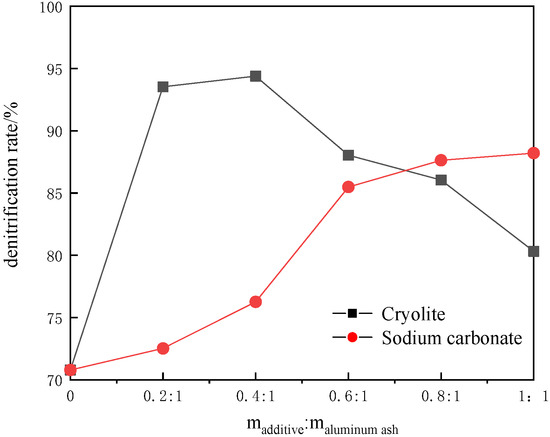
Figure 4.
Effects of different additives on the nitrogen removal rate of high-nitrogen aluminum dross.
It can be seen from Figure 4 that the incorporation of cryolite (cr) and sodium carbonate (sc) will significantly affect the denitrification degree of high-nitrogen aluminum dross (ad). When the amount of cryolite is increased, the denitrification degree will increase first and then decrease. Since excessive cryolite will float on the surface of the sample, this will reduce the contact area between the sample and the air and then cause agglomeration and hardening. Therefore, excessive cryolite will cause a significant decrease in denitrification degree. When the incorporation of sodium carbonate increased, the denitrification degree showed an upward trend. When msc:mad = 0.4:1, the denitrification degree increased sharply. When msc:mad = 0.8:1, the denitrification degree basically tended to the maximum. This is mainly because sodium carbonate can react with alumina to destroy the dense oxide film, thereby increasing the denitrification degree. In addition, during the roasting process, sodium carbonate can decompose to produce oxygen, causing the oxygen concentration in the sample to increase. XRD tests are conducted on samples with different additive ratios, so as to study the phase transformation law between different additive ratios. The XRD pattern is shown in Figure 5.
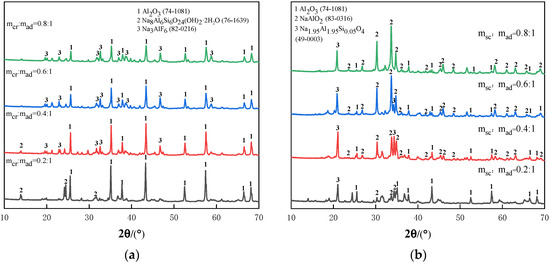
Figure 5.
XRD patterns of different ingredient ratios. (a) XRD pattern of sample with cryolite; (b) XRD pattern of sample with sodium carbonate.
It can be seen from Figure 5 that as the additive ratio increased, the diffraction intensity of the alumina gradually decreased. For samples with cryolite added, the products after roasting denitrification were mainly Al2O3, Na3AlF6, and Na8Al6Si6O24(OH)2·2H2O. When mcr:mad = 0.4:1, the diffraction peak of the cryolite appeared in the XRD spectrum. Moreover, with the increase of the proportioning ratio, the number and intensity of cryolite diffraction peaks increased, while the diffraction peak intensity of the Al2O3 did not change significantly at this time. Therefore, it can be considered that when the proportioning ratio exceeds 0.4, the promotional effect of adding cryolite on aluminum dross denitrification is less than that of the inhibition effect of sintering on aluminum dross denitrification. With the increase of cryolite addition, the diffraction peak of the sodalite (Na8Al6Si6O24(OH)2·2H2O) decreased slowly until it disappeared; this was mainly because the Al/Si ratio in the ideal cell composition of sodalite is one. Therefore, when the amount of cryolite increased, the Al/Si was farther and farther away from the ideal cell composition, which made it difficult to form sodalite. Based on Figure 4, it can be concluded that mcr:mad = 0.4:1 is the optimal additive ratio, with the denitrification degree of 94.39%.
For the sample with sodium carbonate added, the products after roasting denitrification were mainly Al2O3, NaAlO2, and Na1.95Al1.95Si0.05O4. Na1.95Al1.95Si0.05O4, known as zeolite, is a compound with a cellular structure. With the increase of sodium carbonate addition, the diffraction intensity of alumina decreased, and the diffraction intensity of the sodium meta-aluminate increased. Therefore, it can be proved that the chemical reaction involved in Formula (5) did occur in the roasting process, which transformed the dense alumina into sodium aluminate and placed the oxygen more fully in contact with the AlN. Based on Figure 4, it can be concluded that msc:mad = 0.8:1 is the optimal additive ratio, with the denitrification degree of 87.63%.
3.2.2. The Effect of Roasting Temperature on the Nitrogen Removal of High-Nitrogen Aluminum Dross by Roasting
Under different temperature conditions, the experimental samples with the additive ratios of mcr:mad = 0.4:1 and msc:mad = 0.8:1 were placed in electric resistance furnace and roasted for 4 h to explore the effects of different additives on the denitrification degree of high-nitrogen aluminum dross under different temperature conditions. The experimental results are shown in Figure 6.
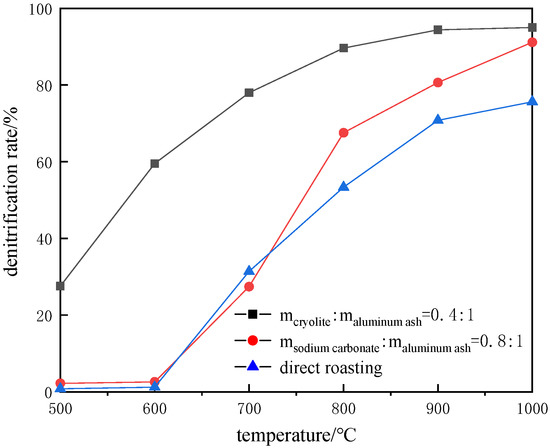
Figure 6.
Effects of different temperatures on the nitrogen removal rate of high-nitrogen aluminum dross.
It can be seen from Figure 6 that the denitrification degree showed an upward trend as the temperature increased. For samples with cryolite, as the temperature increased, the denitrification degree gradually increased. At around 900 °C, the denitrification degree reached 94.41%. When the temperature increased to 1000 °C, the denitrification degree was 95.02%. The two did not change much. Therefore, the optimal roasting temperature for nitrogen removal with cryolite was 900 °C. The denitrification degree of direct roasting at the same temperature was only 70.79%. For the sample with sodium carbonate added, the effect was not obvious at the low temperature stage. As the temperature increased above 600 °C, the denitrification degree increased sharply. This was mainly because the alumina reacted with sodium carbonate when the temperature rose. At this time, more AlN was exposed to the air atmosphere, resulting in an increase in the denitrification degree. At 1000 °C, the denitrification degree reached the maximum of 91.15%. Therefore, the optimal roasting temperature for nitrogen removal with sodium carbonate added was 1000 °C. The denitrification degree of direct roasting at the same temperature was only 75.05%. The samples treated with different roasting temperatures were tested by XRD to study the phase transformation law under different roasting temperature conditions, as shown in Figure 7.
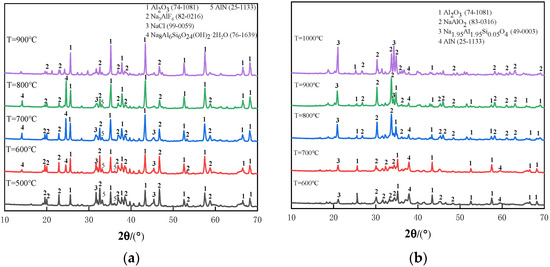
Figure 7.
XRD patterns of different temperatures. (a) XRD pattern of the sample with cryolite; (b) XRD pattern of the sample with sodium carbonate.
For the sample with cryolite added, there was mainly Al2O3, Na3AlF6, NaCl, and Na8Al6Si6O24(OH)2·2H2O in the sample during roasting. With increases in temperature, the diffraction intensity of the Al2O3 did not change significantly. Therefore, it can be known that the principle of denitrification via the addition of cryolite does not directly destroy the oxide film wrapped on the surface of AlN, but the oxygen atom in the oxygen can replace the fluoride atom in the cryolite during roasting to produce a gas similar to OxF2x. Since OxF2x is more oxidizing than oxygen, AlN can be oxidized at a lower temperature to form NyFx and Al2O3, and the reaction between NyFx and O2 can form OxF2x again, so that the reaction can continue.
For the sample with sodium carbonate added, Al2O3, NaAlO2, and Na1.95Al1.95Si0.05O4 were mainly present in the sample during roasting. With increases in temperature, the diffraction peak intensity of the Al2O3 decreased—some even peaks disappeared, while the diffraction peak intensity of the NaAlO2 increased. Therefore, the addition of sodium carbonate to remove AlN in high-nitrogen aluminum dross was mainly achieved by converting Al2O3 into NaAlO2 and destroying the dense oxide film wrapped on the surface of the AlN. In addition, Na1.95Al1.95Si0.05O4 will be produced during roasting, as shown in Formula (7). CO2 will be produced during the formation of Na1.95Al1.95Si0.05O4, which makes the surface of the material loose and porous, with many micropores inside. Therefore, more air will enter the sample, which improves the denitrification degree [18].
1.95NaCO3 + 1.95 Al2O3 + SiO2 = 2Na1.95Al1.95Si0.05O4 + 1.95CO2,
3.2.3. The Effect of Roasting Time on the Nitrogen Removal of High-Nitrogen Aluminum Dross by Roasting
The experimental samples with the additive ratios of mcr:mad = 0.4:1 and msc:mad = 0.8:1 were roasted in an electric resistance furnace at 900 °C and 1000 °C for different times to study the effect of roasting time on the denitrification degree of high-nitrogen aluminum dross. The experimental results are shown in Figure 8.
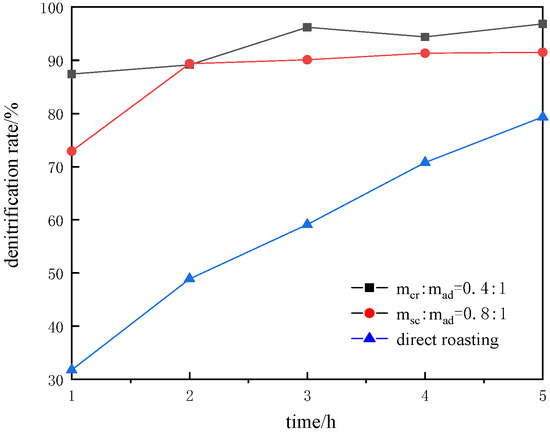
Figure 8.
Effect of different times on the nitrogen removal rate of high-nitrogen aluminum dross.
It can be seen from Figure 8 that as the roasting time increased, the denitrification degree of the high-nitrogen aluminum dross showed an upward trend. For samples with cryolite added, the denitrification degree increased significantly after 2 h of calcination, then remained basically unchanged, and then reached the maximum value of 96.19% at 3 h. Therefore, the optimal roasting time for nitrogen removal with cryolite was 3 h. Under the same roasting temperature and roasting time, the denitrification degree of the direct roasting was only 59.12%. For the sample with sodium carbonate added, the denitrification degree was basically maintained at about 90% after 4 h of calcination. After that, increasing the roasting time had no significant effect on the denitrification degree. Therefore, the optimal roasting time for nitrogen removal with sodium carbonate added was 4 h, with a denitrification degree of 91.32%. Under these conditions, the denitrification degree of direct roasting was only 70.79%.
3.3. TG-DSC Analysis
The experimental samples with the additive ratios of mcr:mad = 0.4:1 and msc:mad = 0.8:1 were analyzed by TG-DSC to study the law of weight change, as well as the endothermic and exothermic changes of the sample during calcination from room temperature to 1000 °C. The experimental results are shown in Figure 9.
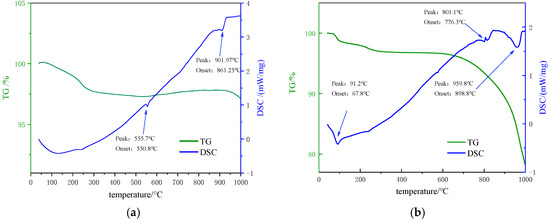
Figure 9.
TG-DSC curve. (a) with cryolite added; (b) with sodium carbonate added.
It can be seen from Figure 9a that at about 100 °C, the TG curve dropped significantly, and the endothermic peak occurred in the DSC curve. This was mainly due to the evaporation of free water absorbed on the sample surface. At 550.8 °C, the TG curve did not change significantly, and a small endothermic peak appeared in the DSC curve. This was mainly due to the endothermic melting of a small amount of metallic aluminum in the sample. At 901.97 °C, an obvious endothermic peak appeared in the DSC curve, and the TG curve had no obvious change. This was mainly because cryolite melts Al2O3 in this temperature range. When the temperature increased to 1000 °C, there were no obvious endothermic peaks and exothermic peaks in the DSC curve, while the TG curve showed a downward trend. This was mainly because a small number of substances in the aluminum dross volatilized. It can be seen from Figure 9b that at about 100 °C, the endothermic peak appeared in the DSC curve, and the mass in the TG curve began to decrease. This was mainly due to the evaporation of adsorbed water on the sample surface. At about 800 °C, the DSC curve showed an endothermic peak, and the TG curve showed an obvious downward trend. This was mainly due to the reaction between the alumina and sodium carbonate. At about 960 °C, the DSC curve had an obvious endothermic peak, and the quality of the TG curve was reduced. This was mainly due to the decomposition of part of the sodium carbonate.
3.4. Morphology of the Samples before and after Roasting
Samples with different additive ratios and roasting process conditions were analyzed by micromorphology. The SEM picture is shown in Figure 10. Figure 10a shows the micromorphology of the high-nitrogen aluminum dross before roasting. It can be seen that there were a lot of irregularly shaped particles agglomerated together. The larger ones were alumina particles, and the rest were AlN and some small impurities. Figure 10b shows the sample micromorphology when msc:mad = 0.8:1, the roasting temperature was 1000 °C, and the roasting time was 4 h. It can be seen that the micro shape of the sample was relatively regular, that there were pores on the sample surface, and that there were relatively few heterogeneous grains. Figure 10c shows the sample micromorphology when mcr:mad = 0.4:1, the roasting temperature was 900 °C, and the roasting time was 3 h. It can be seen that the sample particle shape was mostly flakes that crossed each other. There were still a few impure phases on the surface of the flaky particles, and they were looser compared to Figure 10b,c, which was more conducive to the contact between AlN and oxygen and the increase in denitrification degree.

Figure 10.
SEM images of different additive ratios and roasting processes. (a) Micromorphology of the high-nitrogen aluminum dross; (b) with sodium carbonate added; (c) with cryolite added.
The samples after the different roasting processes were compared and analyzed by micromorphology. According to the relevant experimental results, the micromorphology of the high-nitrogen aluminum dross after roasting became more regular, and the specific surface area became larger, which made the AlN more fully in contact with the air and improved the denitrification degree. Therefore, the poor effect of the direct roasting nitrogen removal was mainly due to the insufficient contact of AlN with the air, due to being wrapped by other substances.
4. Conclusions
In view of a single non-harmful treatment method for high-nitrogen aluminum dross and the difficulties in the efficient removal of AlN, the roasting denitrification degree was accelerated by adding cryolite and sodium carbonate, and the optimum process parameters were studied. The conclusions are as follows:
(1) The optimal process of nitrogen removal for adding cryolite: for mcr:mad = 0.4:1, a roasting temperature of 900 °C, and a roasting time of 3 h, the denitrification degree was 96.19%. The optimal process of nitrogen removal for adding sodium carbonate: for msc:mad = 0.8:1, a roasting temperature of 1000 °C, and a roasting time of 4 h, the denitrification degree was 91.32%.
(2) The main reason for adding cryolite for denitrification is that in the roasting process, the micro morphology of the sample became flakey with a layered structure, which effectively increased the contact area between the sample and air, so as to improve the denitrification degree.
(3) The main reason for adding sodium carbonate to improve the denitrification degree of aluminum dross is that sodium carbonate and Al2O3 can produce stress at about 800 °C, which destroys the oxide film wrapped on the surface of AlN—thus increasing the contact area between the N and the air and improving the denitrification degree.
(4) The poor effect of the direct roasting nitrogen removal was mainly due to insufficient contact with the air caused by AlN being wrapped by alumina and other impurities. After roasting, the microscopic shape of the sample was more regular and the specific surface area became larger, which made the contact between the AlN and air more sufficient and improved the denitrification degree.
Author Contributions
Conceptualization, H.-J.N. and X.-X.W.; methodology, Y.Z.; validation, Y.Z.; formal analysis, H.-J.N. and S.-S.L.; investigation, Y.Z. and X.-X.W.; resources, H.-J.N. and S.-S.L.; writing—original draft preparation, Y.Z.; writing—review and editing, H.-J.N. and S.-S.L.; visualization, C.-Y.L. and W.-Y.W.; supervision, H.-J.N. All authors have read and agreed to the published version of the manuscript.
Funding
This research was supported by the Priority Academic Program Development of Jiangsu Higher Education Institutions, grant number PAPD.
Institutional Review Board Statement
Not applicable.
Informed Consent Statement
Not applicable.
Data Availability Statement
The authors confirm that the data supporting the findings of this study are available within the article.
Conflicts of Interest
The authors declare no conflict of interest.
References
- Ministry of Ecology and Environment of the People’s Republic of China. National List of Hazardous Wastes (2021 Edition), Order No. 15 of the Ministry of Ecology and Environment; Ministry of Ecology and Environment of the People’s Republic of China: Beijing, China, 2021.
- Sarker, S.; Alam, Z.; Qadir, R.; Gafur, M.; Moniruzzaman, M. Extraction and characterization of alumina nanopowders from aluminum dross by acid dissolution process. Int. J. Miner. Metall. Mater. 2015, 22, 429–436. [Google Scholar] [CrossRef]
- Lv, S.S.; Zhang, J.Q.; Ni, H.J.; Wang, X.X.; Zhu, Y.; Gu, T. Study on Preparation of Aluminum Ash Coating Based on Plasma Spray. Appl. Sci. 2019, 9, 4980. [Google Scholar] [CrossRef] [Green Version]
- Ni, H.J.; Zhang, J.Q.; Lv, S.S.; Gu, T.; Wang, X.X. Performance Optimization of Original Aluminum Ash Coating. Coatings 2020, 10, 831. [Google Scholar] [CrossRef]
- Tsakiridis, P.; Ouatadakis, P.; Agatzini, L. Aluminium recovery during black dross hydrothermal treatment. J. Environ. Chem. Eng. 2013, 1, 23–32. [Google Scholar] [CrossRef]
- Mahinroosta, M.; Allahverdi, A. Enhanced alumina recovery from secondary aluminum dross for high purity nanostructured γ-alumina powder production: Kinetic study. J. Environ. Manag. 2018, 212, 278–291. [Google Scholar] [CrossRef] [PubMed]
- Mirian, C.S.; Raphael, H. Effect of disposal of aluminum recycling waste in soil and water bodies. Environ. Earth Sci. 2016, 75, 1–10. [Google Scholar]
- Bruckard, W.J.; Woodcock, J.T. Recovery of valuable materials from aluminium salt cakes. Int. J. Miner. Process. 2009, 93, 1–5. [Google Scholar] [CrossRef]
- Wang, J.H.; Zhong, Y.Q.; Tong, Y.; Xu, X.L.; Lin, G.Y. Removal of AlN from secondary aluminum dross by pyrometallurgical treatment. J. Cent. South Univ. 2021, 28, 386–397. [Google Scholar] [CrossRef]
- Li, Y.; Peng, L.; Wang, H.; Qing, Z.; Qu, Y.; Li, Y.; Li, C.; Wang, Y. Experimental study on denitrification and fluorine fixation of secondary aluminum dross by high temperature roasting. Conserv. Util. Miner. Resour. 2020, 40, 133–140. (In Chinese) [Google Scholar]
- Cong, L.L.; Wang, F.; Jin, Y.; Yuan, Y.J. Determination of aluminum nitride in aluminum dross by Kjeldahl method. Chem. Anal. Meterage 2020, 29, 63–66. (In Chinese) [Google Scholar]
- Huang, Y.X.; Sun, W.Z. Common Chemical Element Analysis Methods; Chemical Industry Press: Beijing, China, 2008; pp. 217–220. (In Chinese) [Google Scholar]
- Lv, S.S.; Ni, W.; Ni, H.J.; Wang, X.X. Study on hydrolysis of aluminum dross based on orthogonal experiment and nonlinear regression analysis. Nonferr. Met. Eng. 2019, 9, 52–56. (In Chinese) [Google Scholar]
- Bazhin, V.Y.; Boikov, A.V.; Sman, A.V.; Ivanov, P.V. Optoelectronic method for monitoring the state of the cryolite melt in aluminum electrolyzers. Russ. J. Non-Ferr. Met. 2015, 56, 6–9. [Google Scholar] [CrossRef] [Green Version]
- Jong, W.; Lee, H. Thermal and carbothermic decomposition of Na2CO3 and Li2CO3. Metall. Mater. Trans. B 2001, 32, 17–24. [Google Scholar]
- Guo, H.; Wang, J.; Zhang, X.; Zheng, F.; Li, P. Study on the extraction of aluminum from aluminum dross using alkali roasting and subsequent synthesis of mesoporous γ-alumina. Metall. Mater. Trans. B 2018, 49, 2906–2916. [Google Scholar] [CrossRef]
- Tang, L. Study on Conversion of Aluminum Nitride in Aluminum Dross during Roasting and Hydrolysis; Northeastern University: Boston, MA, USA, 2015. (In Chinese) [Google Scholar]
- Li, Y.; Chen, X.; Liu, B. Experimental Study on Denitrification of Black Aluminum Dross. JOM 2021, 73, 2635–2642. [Google Scholar] [CrossRef]
Publisher’s Note: MDPI stays neutral with regard to jurisdictional claims in published maps and institutional affiliations. |
© 2022 by the authors. Licensee MDPI, Basel, Switzerland. This article is an open access article distributed under the terms and conditions of the Creative Commons Attribution (CC BY) license (https://creativecommons.org/licenses/by/4.0/).